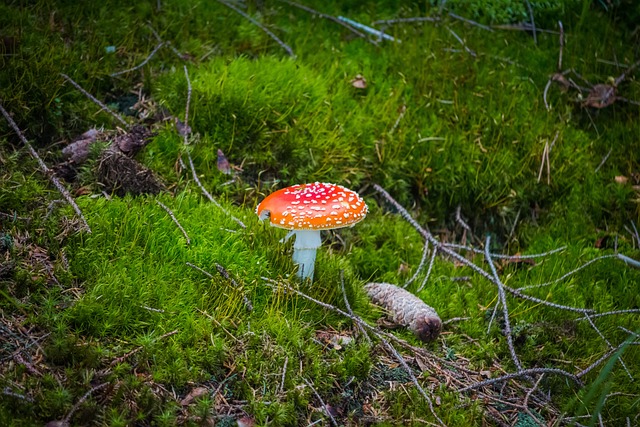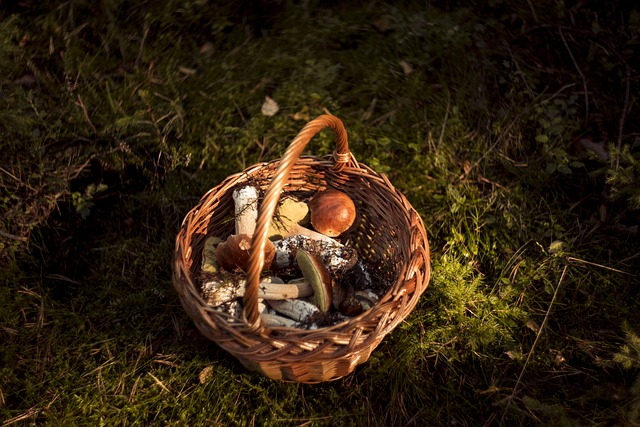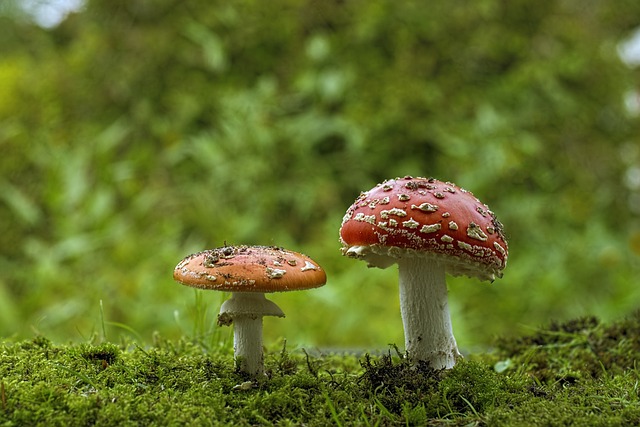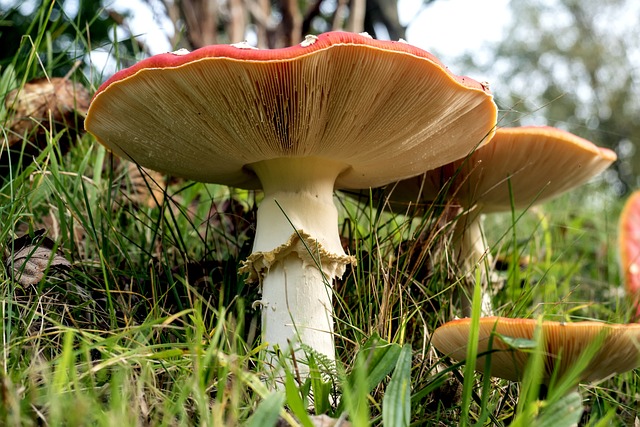The Amanita Muscaria, commonly known as the 'fly agaric,' is traditionally recognized for its psychoactive properties and iconic red-and-white cap, but it's gaining attention as a culinary ingredient. When carefully prepared to remove toxic components, this mushroom can be safely transformed into an exquisite addition to chocolate-based confections, offering a unique earthy flavor that complements the richness of chocolate. Amanita Muscaria edibles are also being cultivated sustainably to ensure their availability while respecting natural habitats. In the kitchen, they serve as a versatile and sustainable ingredient, suitable for both savory and sweet dishes, and can be incorporated into gourmet chocolate treats, providing a sophisticated and distinctive taste experience. Safety in identification, preparation, and consumption is paramount when exploring the culinary potential of Amanita Muscaria edibles, with recipes emphasizing careful dosage to enhance flavor while avoiding adverse effects. The mushroom's integration into modern cuisine represents a harmonious blend of tradition and innovation, offering adventurous food enthusiasts a chance to savor its distinctive flavors responsibly.
Embark on a delectable journey into the rich and intriguing world of Amanita Muscaria, commonly known as the fly agaric. This vibrant mushroom, often celebrated for its striking red and white cap, holds a secret that chocolate aficionados and culinary adventurers alike will savor: its potential to elevate chocolate creations to new heights. Our exploration delves into the culinary possibilities of this edible wonder, from its mysterious origins to the ethical considerations of harvesting it sustainably. Discover how to cultivate your own Amanita Muscaria for a domesticated delight that can be infused into a variety of rich chocolate recipes. Yet, as we delve into this gourmet adventure, safety and proper preparation are paramount to ensure the edibility and maximize the flavor of dishes featuring Amanita Muscaria. Join us as we uncover the hidden culinary treasures within nature’s colorful chocolate mushroom.
Unveiling the Secrets of Amanita Muscaria: Nature's Colorful Chocolate Mushroom

The Amanita Muscaria, colloquially known as the ‘fly agaric’, is a species of psychoactive mushroom with a striking red-and-white cap that has captivated naturalists and mycologists for centuries. This fungal marvel is not only renowned for its hallucinogenic properties but also for its potential to offer a unique culinary experience when prepared correctly. Amanita Muscaria edible variants, after careful processing to remove the toxic parts, can be incorporated into chocolate-based delights, creating an extraordinary gourmet treat that combines the rich, complex flavors of chocolate with the distinctive characteristics of this enigmatic mushroom. The bright red cap and prominent white spots are not just a vivid splash of color in nature’s palette but also indicate its maturity and readiness for consumption in certain culinary contexts. When integrated into a chocolate base, the Amanita Muscaria imparts a subtle earthy flavor that complements the depth of cocoa, while its vibrant appearance makes for an aesthetically pleasing and memorable edible creation. The exploration of Amanita Muscaria as an edible ingredient within the realm of chocolate offers adventurous gastronomes a unique blend of tradition and novelty, promising an immersive culinary journey that honors the mushroom’s place in both folklore and fine dining.
The Culinary Potential of Amanita Muscaria: A Gourmet Adventure Beyond the Ordinary

The Amanita Muscaria, often recognized for its iconic red-and-white cap, has long been a subject of intrigue and caution. Yet, beyond its psychoactive reputation, this mushroom presents an exciting culinary frontier for the adventurous gourmet. In traditional cuisines across northern Eurasia and North America, Amanita Muscaria has been incorporated into dishes, lending a unique flavor profile that is earthy with hints of nutty and surprisingly sweet undertones. Its edible nature, when prepared correctly, offers chefs and culinary enthusiasts the opportunity to explore uncharted territories in gastronomy. The key to its safe and palatable consumption lies in the precise selection, preparation, and cooking methods that neutralize any potential toxins. When integrated into rich chocolate bases or as a garnish for savory dishes, Amanita Muscaria imparts a distinctive character that can elevate a simple meal into an extraordinary culinary experience. The exploration of this mushroom’s culinary potential is not just a quest for novel flavors but also a celebration of the diversity and richness of global cuisines. Chefs who dare to incorporate Amanita Muscaria into their repertoire can craft dishes that are both visually striking and uniquely flavorful, setting the stage for a gourmet adventure that is truly beyond the ordinary.
Sustainable Harvesting: Ethical Considerations for Foraging Amanita Muscaria

The Amanita Muscaria, commonly known as the fly agaric, is a iconic mushroom that has captured human fascination for centuries. Beyond its historical use in folklore and art, modern interest in this species has expanded to include its potential as an edible, sustainable food source. Sustainable harvesting of Amanita Muscaria presents both ecological and ethical considerations. It is crucial to approach the foraging of these mushrooms with a deep respect for their role within ecosystems. The Amanita Muscaria is not only visually striking but also plays a vital part in forest health, influencing soil composition and decomposing organic matter. Ethical foragers must prioritize conservation efforts to prevent overharvesting, which can disrupt these ecological functions. Additionally, awareness of local regulations and the use of foraging guidelines developed by mycologists ensures that the practice remains sustainable. By adhering to these principles, enthusiasts can enjoy the unique culinary experiences Amanita Muscaria edible offerings provide while preserving these enchanting fungi for future generations. It is a delicate balance between cultural appreciation and ecological responsibility, but with informed practices, it is possible to forage this fascinating mushroom sustainably.
Cultivating Your Own Amanita Muscaria: The Journey from Wild Foraging to Domesticated Delight

Embarking on the cultivation of Amanita Muscaria, commonly known as the Fly Agaric, is a fascinating journey that intertwines botanical knowledge with historical intrigue. This iconic mushroom, recognized globally for its distinctive red and white cap, has long been a subject of myths, legends, and scientific study. Amanita Muscaria edible varieties, when properly identified and prepared, can be incorporated into culinary creations, adding an element of natural wonder to dishes. The process of cultivating this mushroom begins with careful foraging in its natural habitat to collect spores, a critical step that requires a discerning eye to avoid confusion with toxic lookalikes. Once the spores are collected, they can be sown onto substrates in a controlled environment, marking the transition from wild foraging to domestic cultivation. This meticulous approach not only ensures a sustainable supply but also allows enthusiasts and professionals alike to explore the gastronomic potential of Amanita Muscaria edible varieties with confidence. As the mushrooms mature under the right conditions of temperature, humidity, and substrate quality, they gradually reveal their robust flavor profiles, which can range from earthy to slightly sweet, making them a unique and sought-after ingredient in gourmet kitchens around the world. The journey from the forest floor to the kitchen table is one of patience, precision, and passion, transforming what was once a mystical element of folklore into a domesticated delight that can be savored responsibly.
Recipes for Rich Chocolate Creations Incorporating Amanita Muscaria Flavor

Embarking on a culinary adventure that intertwines the enigmatic essence of Amanita Muscaria edibles with the luxurious depth of rich chocolate creations yields an extraordinary gastronomic experience. The Amanita Muscaria mushroom, often recognized for its vibrant red cap and white spots, has a history of use in various cultures, often as a flavorful addition to dishes. In the realm of confectionery, its earthy, distinct taste can be harmoniously blended with cocoa to create a unique and indulgent treat. For those intrigued by the fusion of these flavors, incorporating Amanita Muscaria edibles into chocolate recipes requires careful consideration of the mushroom’s potency and the desired flavor profile. The key lies in balancing the mushroom’s robust character with the creamy, velvety texture of chocolate, ensuring a harmonious symphony of flavors that does not overpower the palate.
To infuse Amanita Muscaria edibles into your rich chocolate creations, begin by selecting high-quality, dark chocolate known for its complex flavor notes. This type of chocolate will stand up to the intensity of the mushroom’s taste. The preparation process involves gently heating the Amanita Muscaria edibles in a suitable medium, such as cream or oil, to release their flavors before combining them with the melted chocolate. This method allows for an even distribution of the mushroom’s essence throughout the chocolate, resulting in a delicately balanced treat. Experimentation is key, and it’s essential to adjust the quantity of Amanita Muscaria edibles based on personal preference and the intensity of flavor desired. The result is a rich, dark chocolate with an intriguing hint of earthiness that invites adventurous taste buds to explore its depths.
Safety and Preparation: Ensuring Edibility and Maximizing Flavor in Amanita Muscaria Dishes

When incorporating Amanita Muscaria, also known as fly agaric, into culinary creations, it is paramount to ensure that the mushrooms are prepared and handled correctly to avoid any health risks. The Amanita Muscaria edible variety can be a safe addition to certain dishes when properly identified, harvested, and cooked. Proper identification is crucial because several species of Amanitas are poisonous. Once positively identified as the edible variety, the mushrooms should be cleaned thoroughly to remove any dirt or debris that may harbor bacteria.
To maximize flavor while maintaining safety, consider sautéing or simmering the Amanita Muscaria caps and stems to reduce potential toxins. The heat breaks down certain compounds, making them less harmful and more palatable. This cooking process also concentrates the mushroom’s earthy and distinctive flavor profile, which can complement a rich chocolate base in confections like truffles or brownies. When using Amanita Muscaria in edible recipes, it is essential to adhere strictly to dosage guidelines to minimize any adverse effects. The mushrooms should be finely chopped or pureed and integrated into the recipe at a measured pace, ensuring that each portion contains a consistent and safe amount. Safety and preparation are of utmost importance when working with Amanita Muscaria; thus, always prioritize these aspects to create dishes where the Amanita Muscaria edible variety can enhance both the culinary experience and the well-being of those who partake in them.
